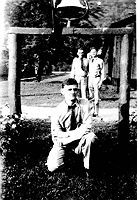As one of the first CCC camps in
West Virginia, Camp Parsons was operational from April 20, 1933 until
nearly the close of the CCC program in 1942. The camp was located near
the town of Parsons in Tucker County and housed CCC Company 518, also
known as F-3.
Company 518 was responsible for assisting in operation and managing the
massive tree nursery adjacent to the camp. The nursery was the heart
and sole source of millions of tree seedlings planted by other CCC
"Boys" throughout West Virginia and elsewhere.
Although a US Forest Service tree nursery had been established
here prior to 1933, the assignment of CCC Company 518 and
establishment of Camp Parsons provided much needed support, and the
nursery was successfully expanded.
From 1933 to 1937, an additional 50 acres of nearby land was purchased
and added to the nursery lands. According to a US Forest Service
report, the Parsons nursery provided seedlings for not only the
Monongahela National Forest, but the Shenandoah, the Allegheny and 6
other forests as well, not to mention many other, unforested
all-points areas of the state.
The report stated: "The nursery was capable of producing as many as 7.5
million seedlings in its beds at one time. Principle species raised in
it were red spruce, white pine, red pine, white spruce, hemlock,
European larch, Japanese larch, red oak, white ash, black locust, black
cherry and yellow poplar." ( re:,"50 Year History of the
Monongahela National Forest; USFS staff report. September, 1970.
page 43.)
Note:
Clicking on an image below opens a new window. Close
window to return here.
|
|
|
K.E. Bolyard, enrollee of Camp Parsons pictured in 1940 near the camp
entrance. It seems most, if not all CCC camps had bells for routine
calls and emergencies. Ibid, page 64.
|

|